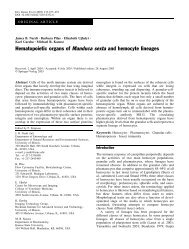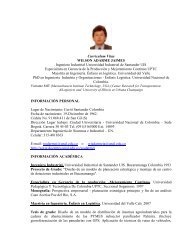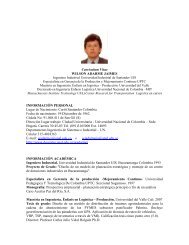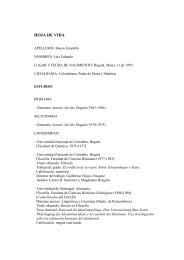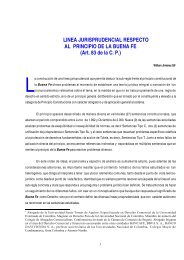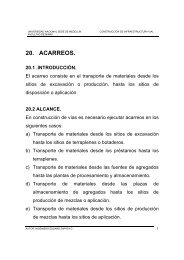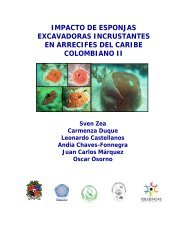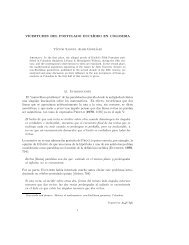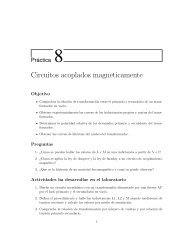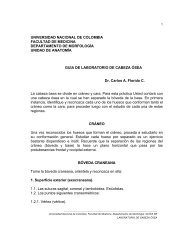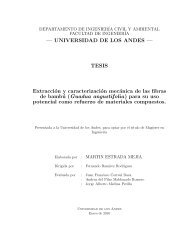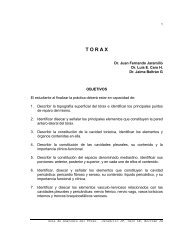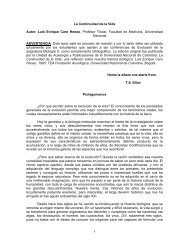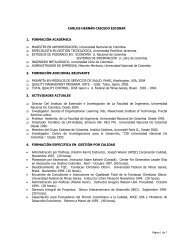Importancia del método estadístico para el cálculo de la CE50 y ...
Importancia del método estadístico para el cálculo de la CE50 y ...
Importancia del método estadístico para el cálculo de la CE50 y ...
Create successful ePaper yourself
Turn your PDF publications into a flip-book with our unique Google optimized e-Paper software.
<strong>Importancia</strong> <strong>d<strong>el</strong></strong> <strong>método</strong> <strong>estadístico</strong> <strong>para</strong> <strong>el</strong> <strong>cálculo</strong> <strong>de</strong> <strong>la</strong> <strong>CE50</strong> y CE95<br />
<strong>de</strong> algunos isotiocianatos evaluados contra Rhizoctonia so<strong>la</strong>ni Kühn<br />
Importance of the statistical method applied to calcu<strong>la</strong>te the EC50 and EC95<br />
of some isothiocyanates evaluated against Rhizoctonia so<strong>la</strong>ni Kühn<br />
Fecha <strong>de</strong> recepción: 25 <strong>de</strong> septiembre <strong>de</strong> 2009. Aceptado <strong>para</strong> publicación: 28 <strong>de</strong> julio <strong>de</strong> 2010<br />
1 Departamento <strong>de</strong> Investigación, Buenas Prácticas Agríco<strong>la</strong>s - BPA Ltda., Bogotá (Colombia).<br />
2 Departamento <strong>de</strong> Agronomía, Facultad <strong>de</strong> Agronomía, Universidad Nacional <strong>de</strong> Colombia, Bogotá (Colombia).<br />
3 Autor <strong>de</strong> corespon<strong>de</strong>ncia. lufemol@yahoo.com<br />
Luis Fe<strong>de</strong>rico Molina-Vargas 1, 3 y Sandra Esperanza M<strong>el</strong>o-Martínez 2<br />
RESUMEN ABSTRACT<br />
En <strong>el</strong> marco <strong>de</strong> <strong>la</strong> evaluación <strong>d<strong>el</strong></strong> efecto algunos isotiocianatos<br />
(ITC) sobre <strong>el</strong> crecimiento <strong>de</strong> Rhizoctonia so<strong>la</strong>ni Kühn, <strong>la</strong> presente<br />
investigación establece también si <strong>el</strong> <strong>método</strong> <strong>estadístico</strong><br />
utilizado <strong>de</strong>termina diferencias consi<strong>de</strong>rables en los valores<br />
<strong>de</strong> <strong>la</strong> concentración efectiva media (<strong>CE50</strong>) y <strong>la</strong> concentración<br />
efectiva 95 (CE95) <strong>de</strong> estos compuestos. Para <strong>el</strong>lo se realizó un<br />
experimento in vitro, y se estimaron dichos valores mediante<br />
regresiones lineales y no lineales. Los compuestos evaluados<br />
contra R. so<strong>la</strong>ni AG-3 fueron: alil isotiocianato (AITC), bencil<br />
isotiocianato (BITC), fenil isotiocianato (PITC), fenetil isotiocianato<br />
(PEITC) y metil isotiocianato (MITC). El ensayo se<br />
llevó a cabo en <strong>el</strong> Laboratorio <strong>de</strong> Biotecnología <strong>de</strong> <strong>la</strong> Facultad<br />
<strong>de</strong> Agronomía <strong>de</strong> <strong>la</strong> Universidad Nacional <strong>de</strong> Colombia, se<strong>de</strong><br />
Bogotá. Manteniendo agitación constante, se pre<strong>para</strong>ron diluciones<br />
<strong>de</strong> los ITC utilizando metanol como solvente, <strong>para</strong><br />
obtener <strong>la</strong>s concentraciones 0,0; 0,01; 0,1; 1,0 y 10,0%, que correspondieron<br />
a los distintos tratamientos evaluados. En cada<br />
uno <strong>de</strong> <strong>el</strong>los se agregaron 50 mL <strong>de</strong> una <strong>de</strong> estas soluciones a <strong>la</strong>s<br />
unida<strong>de</strong>s experimentales, consistentes en cajas <strong>de</strong> petri con medio<br />
PDA y mic<strong>el</strong>io <strong>de</strong> R. so<strong>la</strong>ni AG-3, s<strong>el</strong><strong>la</strong>das herméticamente<br />
y almacenadas a temperatura ambiente. Pasadas 72 y 144 horas<br />
<strong>de</strong>spués <strong>de</strong> <strong>la</strong> aplicación <strong>de</strong> los tratamientos (hdt), se tomaron<br />
fotografías digitales <strong>para</strong> calcu<strong>la</strong>r <strong>el</strong> área <strong>de</strong> crecimiento mic<strong>el</strong>ial<br />
con <strong>el</strong> software MapMaker® 3.5. Esto permitió obtener<br />
<strong>la</strong> Concentración Efectiva Media (<strong>CE50</strong>) y <strong>la</strong> Concentración<br />
Efectiva 95 (CE95) mediante regresiones lineales, no lineales<br />
(mo<strong>d<strong>el</strong></strong>os Gompertz, logístico y polinómico) y análisis Probit.<br />
Los valores obtenidos a partir <strong>de</strong> este último distan bastante <strong>de</strong><br />
lo observado, que a su vez coinci<strong>de</strong> con los valores encontrados<br />
por regresión lineal. A <strong>la</strong> concentración <strong>d<strong>el</strong></strong> 10%, todos los ITC,<br />
excepto PEITC, mostraron un efecto inhibitorio total. Por su<br />
parte, BITC mantuvo su efecto fungistático hasta 21 días <strong>de</strong>spués<br />
<strong>de</strong> aplicados los tratamientos, mientras que PITC, AITC<br />
y MITC mantuvieron un efecto fungistático más prolongado,<br />
inclusive hasta un año <strong>de</strong>spués <strong>de</strong> iniciados los tratamientos.<br />
Pa<strong>la</strong>bras c<strong>la</strong>ve: Gompertz, logístico, polinómico, Probit,<br />
regresiones.<br />
Framed in the evaluation of the effect of some isothiocyanates<br />
(ITC) on the growth of Rhizoctonia so<strong>la</strong>ni Kühn, the present<br />
research also studied whether the applied statistical method<br />
<strong>de</strong>termines significant differences in the values of the Median<br />
(EC50) and 95 (EC95) effective concentrations of these compounds.<br />
For this purpose, we conducted an in vitro experiment<br />
in which said values were calcu<strong>la</strong>ted by different statistical methods.<br />
In vitro efficacy against R. so<strong>la</strong>ni AG-3 was tested of allyl<br />
isothiocyanate (AITC), benzyl isothiocyanate (BITC), phenyl<br />
isothiocyanate (PITC), phenethyl isothiocyanate (PEITC) and<br />
methyl isothiocyanate (MITC). Un<strong>de</strong>r constant shaking we prepared<br />
stock solutions by mixing ITC with methanol as solvent,<br />
to get concentrations of 0.0%, 0.01%, 0.1%, 1.0%, and 10%, corresponding<br />
to the different studied treatments; each of which<br />
consisted in the addition of 50 mL of one of these solutions to<br />
the experimental units. The <strong>la</strong>tter were Petri dishes containing<br />
potato-<strong>de</strong>xtrose-agar medium (PDA) and myc<strong>el</strong>ium of R. so<strong>la</strong>ni<br />
AG-3. These containers were then sealed with two <strong>la</strong>yers of<br />
<strong>para</strong>film and incubated at room temperature. Digital pictures<br />
were taken to obtain the colony areas using MapMaker 3.5®<br />
software, 72 and 144 hours after the treatments were applied.<br />
The Median (EC50) and 95 (EC95) effective concentrations<br />
were calcu<strong>la</strong>ted through linear and non-linear (Gompertz,<br />
logistic, and polynomial mo<strong>d<strong>el</strong></strong>s) regressions, as w<strong>el</strong>l as probit<br />
analysis. The values obtained through the <strong>la</strong>tter were found to<br />
be consi<strong>de</strong>rably different from the actual ones, which in turn<br />
coinci<strong>de</strong>d with those found by means of linear regressions. All<br />
of ITC at 10% concentration were complet<strong>el</strong>y inhibitory, with<br />
the exception of PEITC. Whereas BITC was fungistatic up to<br />
twenty one days after the treatments were applied, PITC, AITC,<br />
and MITC had a longer fungistatic effect, even one year after<br />
treatment application.<br />
Key words: Gompertz, logistic, Probit, regressions.<br />
Agronomía Colombiana 28(2), 00-00, 2010
Introducción<br />
Se ha generalizado <strong>el</strong> uso <strong>d<strong>el</strong></strong> <strong>método</strong> Probit <strong>para</strong> <strong>el</strong> <strong>cálculo</strong><br />
<strong>de</strong> <strong>la</strong> CE 50, in<strong>de</strong>pendientemente <strong>de</strong> si <strong>la</strong> variable respuesta<br />
se trata <strong>de</strong> una variable discreta o <strong>de</strong> una variable continua.<br />
Esa generalización ha sido errónea, posiblemente <strong>de</strong>bido<br />
al <strong>de</strong>sconocimiento <strong>de</strong> los experimentadores sobre <strong>el</strong> uso<br />
apropiado <strong>d<strong>el</strong></strong> análisis (Molina, 2008). Jones et al. (1987)<br />
utilizan <strong>el</strong> análisis Probit <strong>para</strong> calcu<strong>la</strong>r <strong>la</strong> CE 50 <strong>de</strong> benomil<br />
y propiconazol <strong>para</strong> <strong>el</strong> control <strong>de</strong> R. so<strong>la</strong>ni a partir<br />
<strong>de</strong> <strong>la</strong> inhibición <strong>d<strong>el</strong></strong> crecimiento, midiendo como variable<br />
respuesta <strong>el</strong> diámetro <strong>de</strong> <strong>la</strong> colonia. Timmer et al. (1998)<br />
calcu<strong>la</strong>n <strong>el</strong> diámetro <strong>de</strong> <strong>la</strong>s colonias <strong>de</strong> Phytophthora nicotianae,<br />
y establecen <strong>para</strong> cada concentración <strong>de</strong> fungicida<br />
evaluado, <strong>el</strong> área <strong>de</strong> <strong>la</strong> colonia expresada como <strong>el</strong> porcentaje<br />
<strong>de</strong> los tratamientos control (sin fungicida); igualmente<br />
grafican los valores <strong>de</strong> los porcentajes como probits versus<br />
<strong>la</strong> concentración <strong>de</strong> fungicida, en log 10, pero analizan los<br />
datos mediante regresión lineal. Dobson (2002) afirma<br />
que <strong>el</strong> <strong>método</strong> <strong>d<strong>el</strong></strong> análisis <strong>estadístico</strong> <strong>de</strong>pen<strong>de</strong> <strong>de</strong> <strong>la</strong> esca<strong>la</strong><br />
<strong>de</strong> medida <strong>de</strong> <strong>la</strong> variable respuesta y <strong>de</strong> <strong>la</strong> variable in<strong>de</strong>pendiente,<br />
y recomienda <strong>el</strong> uso <strong>de</strong> regresiones cuando <strong>la</strong><br />
variable respuesta es una variable continua.<br />
Para <strong>la</strong> estimación <strong>de</strong> <strong>la</strong> concentración efectiva (CE) que<br />
causa cierto porcentaje <strong>de</strong> inhibición en pruebas <strong>de</strong> toxicidad<br />
microbiales, los mo<strong>d<strong>el</strong></strong>os <strong>de</strong> regresión lineales han<br />
sido recomendados sobre otros mo<strong>d<strong>el</strong></strong>os convencionales<br />
como Probit o Logit (Madhavi et al., 1995). Los análisis<br />
<strong>de</strong> regresión <strong>de</strong> mínimos cuadrados ordinarios son apropiados<br />
<strong>de</strong>s<strong>de</strong> ciertos supuestos, como <strong>el</strong> <strong>de</strong> que <strong>la</strong> variable<br />
<strong>de</strong>pendiente es una variable continua (Spector y Mazzeo,<br />
1980). Las regresiones lineales se utilizan <strong>para</strong> calcu<strong>la</strong>r <strong>la</strong><br />
CE 50, <strong>para</strong> variables respuesta medidas en porcentaje, en<br />
diferentes tipos <strong>de</strong> experimentos (Afek y Sztejnberg, 1989;<br />
Baldrian y Gabri<strong>el</strong>, 2002; Huang y Mau, 2006; Huang y<br />
Mau, 2007; Kinay et al., 2007; Lee et al., 2008; Li y Xiao,<br />
2008; Ma y Chen, 2005; Madhavi et al., 1995; Mu et al.,<br />
2006; Muñoz et al., 2009; Ritchie et al., 2001; Timmer et<br />
al., 1998; Tseng et al., 2006; Witte et al., 1995; Xiao et al.,<br />
2007; Yang et al., 2006; Yen et al., 2007; Yen et al., 2008;<br />
Zhang et al., 2007 y Zhu et al., 2008).<br />
El objetivo <strong>d<strong>el</strong></strong> presente trabajo fue estandarizar un <strong>método</strong><br />
que permita evaluar <strong>la</strong> eficacia in vitro <strong>de</strong> los isotiocianatos<br />
(ITC) contra Rhizoctonia so<strong>la</strong>ni Kühn, utilizando <strong>la</strong><br />
inhibición <strong>d<strong>el</strong></strong> crecimiento mic<strong>el</strong>ial. Mediante curvas <strong>de</strong><br />
dosis-respuesta se calcu<strong>la</strong>ron los valores <strong>de</strong> <strong>la</strong> concentración<br />
efectiva media (CE 50) y <strong>la</strong> concentración efectiva 95 (CE 95),<br />
por diferentes <strong>método</strong>s <strong>estadístico</strong>s y se com<strong>para</strong>ron con<br />
los valores obtenidos mediante <strong>el</strong> análisis Probit.<br />
Materiales y <strong>método</strong>s<br />
En <strong>el</strong> Laboratorio <strong>de</strong> Biotecnología <strong>de</strong> <strong>la</strong> Facultad <strong>de</strong> Agronomía<br />
<strong>de</strong> <strong>la</strong> Universidad Nacional <strong>de</strong> Colombia, se<strong>de</strong> Bogotá,<br />
se realizó un experimento in vitro, en cámara <strong>de</strong> flujo<br />
<strong>la</strong>minar y cámara <strong>de</strong> extracción <strong>de</strong> gases, <strong>para</strong> evaluar <strong>la</strong><br />
eficacia <strong>de</strong> cinco ITC contra un ais<strong>la</strong>miento AG-3 <strong>de</strong> <strong>la</strong> colección<br />
<strong>de</strong> R. so<strong>la</strong>ni Kühn <strong>de</strong> dicho <strong>la</strong>boratorio. Como medio<br />
<strong>de</strong> cultivo se utilizó Papa Dextrosa Agar (PDA) al 3,9%,<br />
en cajas <strong>de</strong> petri <strong>de</strong> 9 cm <strong>de</strong> diámetro. Con un sacabocado<br />
manual, se abrieron huecos (bolsillos) <strong>de</strong> un cm 2 <strong>de</strong> área en<br />
<strong>el</strong> medio solidificado, al bor<strong>de</strong> <strong>de</strong> <strong>la</strong>s pare<strong>de</strong>s <strong>de</strong> <strong>la</strong> caja <strong>de</strong><br />
petri. En <strong>el</strong> extremo diametralmente opuesto al bolsillo, se<br />
colocó como inóculo un disco <strong>de</strong> mic<strong>el</strong>io recortado <strong>de</strong> los<br />
bor<strong>de</strong>s <strong>de</strong> colonias proveniente <strong>de</strong> cultivo <strong>d<strong>el</strong></strong> hongo <strong>de</strong> 5 d<br />
<strong>de</strong> sembrado. Los ITC evaluados fueron alil isotiocianato<br />
(AITC) al 93%, bencil isotiocianato (BITC) al 98%, fenil<br />
isotiocianato (PITC) al 99%, fenetil isotiocianato (PEITC)<br />
al 99%, obtenidos <strong>de</strong> Sigma Aldrich y metil isotiocianato<br />
(MITC) como testigo comercial, producto <strong>de</strong> <strong>la</strong> <strong>de</strong>gradación<br />
<strong>d<strong>el</strong></strong> ingrediente activo dazomet (NRA, 1997; Crnogorac<br />
y Schwack, 2009) al 98% <strong>d<strong>el</strong></strong> producto Basamid® (BASF). Se<br />
utilizó metanol como solvente (Petersen et al., 2001; Chung<br />
et al., 2002) al 99,9% (JTBaker). Las soluciones stock <strong>para</strong><br />
cada ITC se pre<strong>para</strong>ron agregando 100 mL <strong>de</strong> metanol a 100<br />
mL <strong>d<strong>el</strong></strong> respectivo ITC, manteniendo en agitación constante<br />
a 500 rpm. Para cada ITC, <strong>la</strong>s diluciones <strong>de</strong> 0,0; 0,01; 0,1;<br />
1,0 y 10,0% (equivalente a 0, 100, 1.000, 10.000 y 100.000<br />
mg kg -1 , respectivamente) se pre<strong>para</strong>ron agregando a muestras<br />
<strong>de</strong> <strong>la</strong> solución stock agua <strong>de</strong>sti<strong>la</strong>da estéril y metanol,<br />
manteniendo en agitación constante. Para evaluar <strong>el</strong> efecto<br />
<strong>d<strong>el</strong></strong> solvente, se obtuvo <strong>la</strong> concentración más alta, a <strong>la</strong> cual<br />
no se observó ningún efecto (NOEL, <strong>de</strong> su sig<strong>la</strong> en inglés:<br />
no-observed effect lev<strong>el</strong>) (Fukushima et al., 2005), tanto a<br />
<strong>la</strong>s 72 horas <strong>de</strong>spués <strong>de</strong> aplicados los tratamientos (hdt)<br />
como a <strong>la</strong>s 144 hdt, com<strong>para</strong>ndo <strong>la</strong>s áreas <strong>de</strong> crecimiento<br />
mic<strong>el</strong>ial mediante <strong>la</strong>s pruebas <strong>de</strong> Dunnett y <strong>de</strong> Tukey. Se<br />
<strong>de</strong>terminó utilizar una solución <strong>de</strong> agua con metanol como<br />
solvente, en una concentración al 20% (r<strong>el</strong>ación 80:20),<br />
previa verificación <strong>d<strong>el</strong></strong> cumplimiento <strong>de</strong> los supuestos <strong>de</strong><br />
normalidad y <strong>de</strong> homogeneidad <strong>de</strong> varianzas, bajo un niv<strong>el</strong><br />
<strong>de</strong> significancia <strong>d<strong>el</strong></strong> 0,05. En los bolsillos abiertos en medios<br />
solidificados <strong>de</strong> PDA, se agregaron 50 mL <strong>de</strong> <strong>la</strong> respectiva<br />
dilución <strong>para</strong> cada tratamiento. Los testigos absolutos<br />
recibieron una cantidad <strong>de</strong> solvente equivalente a <strong>la</strong> usada<br />
en los tratamientos con ITC (solución <strong>de</strong> agua <strong>de</strong>sti<strong>la</strong>da<br />
estéril y metanol, en una r<strong>el</strong>ación 80:20). Las cajas <strong>de</strong> petri<br />
se cubrieron con doble capa <strong>de</strong> pap<strong>el</strong> <strong>para</strong>film (Chung et<br />
al., 2002) y se incubaron a temperatura ambiente durante<br />
siete días, en cajas <strong>de</strong> cartón en campana <strong>de</strong> extracción <strong>de</strong><br />
gases. El experimento se repitió tres veces.<br />
258 Agron. Colomb. 28(2) 2010
Como variable respuesta se calculó <strong>el</strong> porcentaje <strong>de</strong><br />
inhibición, con base en <strong>el</strong> área <strong>de</strong> crecimiento mic<strong>el</strong>ial.<br />
Se tomaron fotografías digitales a <strong>la</strong>s 72 y a <strong>la</strong>s 144 hdt<br />
y se calcu<strong>la</strong>ron <strong>la</strong>s áreas (en cm 2 ), con <strong>la</strong>s herramientas<br />
“Polygon” y “Measurement: Flood-fill area measurer” <strong>d<strong>el</strong></strong><br />
software MapMaker® (Map Maker Ltd, Argyll, UK). Al<br />
área <strong>de</strong> crecimiento mic<strong>el</strong>ial <strong>de</strong> cada tratamiento se le restó<br />
<strong>el</strong> área correspondiente al disco <strong>de</strong> inóculo y se calculó<br />
<strong>la</strong> reducción r<strong>el</strong>ativa <strong>d<strong>el</strong></strong> crecimiento (RRC) sugerida por<br />
Taylor et al. (2002). La variable respuesta RRC (porcentaje<br />
<strong>de</strong> inhibición) fue <strong>de</strong>terminada mediante (1).<br />
[100 - (área <strong>de</strong> crecimiento con ITC/<br />
área <strong>de</strong> crecimiento <strong>de</strong> tratamientos control)*100] (1)<br />
Análisis <strong>estadístico</strong><br />
Mediante regresiones lineales y los mo<strong>d<strong>el</strong></strong>os Gompertz,<br />
logístico y polinómico (regresiones no lineales) se estableció<br />
<strong>la</strong> r<strong>el</strong>ación entre <strong>la</strong> concentración <strong>de</strong> ITC (x) con <strong>el</strong><br />
porcentaje <strong>de</strong> inhibición (y) y se obtuvieron <strong>la</strong>s respectivas<br />
ecuaciones. Con dichas ecuaciones se calcu<strong>la</strong>ron los<br />
valores <strong>de</strong> <strong>la</strong> CE 50 y CE 95, y se com<strong>para</strong>ron con los valores<br />
obtenidos mediante <strong>el</strong> análisis Probit. Los análisis <strong>estadístico</strong>s<br />
se realizaron mediante los procedimientos Means,<br />
Univariate, Reg, Glm, Nlin y Probit <strong>d<strong>el</strong></strong> paquete <strong>estadístico</strong><br />
SAS (Statistical Analysis System) v. 9.0. (SAS Institute, Inc.<br />
Cary, NC). La CE 50 hace referencia a <strong>la</strong> concentración <strong>de</strong><br />
un componente anti-fúngico que es requerida <strong>para</strong> inhibir<br />
<strong>el</strong> 50% <strong>d<strong>el</strong></strong> crecimiento <strong>d<strong>el</strong></strong> hongo (Taylor et al., 2002; Li y<br />
Xiao, 2008). Se conoce también como IC50 (<strong>de</strong> su sig<strong>la</strong> en<br />
inglés: inhibit concentration 50%) (Koenraad et al., 2001)<br />
o ED50 (<strong>de</strong> su sig<strong>la</strong> en inglés: effective dosis 50) (Baldrian y<br />
Gabri<strong>el</strong>, 2002), y se constituye en <strong>la</strong> variable utilizada <strong>para</strong><br />
evaluar <strong>la</strong> sensibilidad <strong>de</strong> R. so<strong>la</strong>ni a diferentes fungicidas<br />
midiendo <strong>el</strong> diámetro <strong>d<strong>el</strong></strong> mic<strong>el</strong>io <strong>de</strong> <strong>la</strong> colonia (Martin et<br />
al., 1984; Jones et al., 1987; Carling et al., 1990; Hajieghrari<br />
et al., 2006; Jones et al., 2007) y <strong>para</strong> evaluar <strong>la</strong> eficacia <strong>de</strong><br />
fungicidas fumigantes (Hutchinson et al., 2000).<br />
Cada ITC se evaluó con un diseño experimental <strong>de</strong> bloques<br />
completamente aleatorizado (DBCA), siendo <strong>la</strong>s concentraciones<br />
al 0,0; 0,01; 0,1; 1,0 y 10,0% <strong>el</strong> factor <strong>de</strong> c<strong>la</strong>sificación, y<br />
<strong>la</strong> asignación <strong>de</strong> los tratamientos a <strong>la</strong>s unida<strong>de</strong>s experimentales<br />
se hizo en forma aleatoria (aleatorización irrestricta)<br />
(M<strong>el</strong>o et al., 2007). Los bloques correspondieron a <strong>la</strong>s tres<br />
repeticiones <strong>d<strong>el</strong></strong> experimento en <strong>la</strong>s mismas condiciones.<br />
Las unida<strong>de</strong>s experimentales fueron cajas <strong>de</strong> petri, con<br />
medio PDA al 3,9%, con discos <strong>de</strong> mic<strong>el</strong>io <strong>de</strong> R. so<strong>la</strong>ni AG-3<br />
<strong>de</strong> 5 d <strong>de</strong> sembrado. El mo<strong>d<strong>el</strong></strong>o lineal, <strong>para</strong> cada ITC, con<br />
cinco réplicas por tratamiento, fue (2).<br />
don<strong>de</strong>:<br />
2010 Molina-Vargas y M<strong>el</strong>o-Martínez: <strong>Importancia</strong> <strong>d<strong>el</strong></strong> <strong>método</strong> <strong>estadístico</strong> <strong>para</strong> <strong>el</strong> <strong>cálculo</strong> <strong>de</strong> <strong>la</strong> CE 50 y CE 95 <strong>de</strong> los isotiocianatos...<br />
y ijk = m + t i + b j + e ijk (2)<br />
y ijk: área <strong>de</strong> crecimiento mic<strong>el</strong>ial promedio,<br />
m: efecto media general,<br />
t i: efecto <strong>de</strong> <strong>la</strong> i-ésima concentración,<br />
i = 1, …,5<br />
b j: efecto <strong>d<strong>el</strong></strong> j-ésimo bloque (experimento),<br />
j = 1, 2 y 3<br />
E ijk: efecto <strong>d<strong>el</strong></strong> error experimental,<br />
k = 1,…,5 (réplicas)<br />
Cálculo <strong>de</strong> <strong>la</strong> concentración efectiva (CE)<br />
Los parámetros <strong>para</strong> <strong>la</strong>s ecuaciones fueron obtenidos<br />
mediante <strong>el</strong> procedimiento Reg <strong>para</strong> <strong>la</strong>s regresiones lineales<br />
y <strong>el</strong> procedimiento Nlin <strong>para</strong> los mo<strong>d<strong>el</strong></strong>os Gompertz,<br />
logístico y polinómico. Para obtener los valores <strong>de</strong> <strong>la</strong> CE 50,<br />
correspondiente a <strong>la</strong> concentración <strong>de</strong> ITC que inhibe <strong>el</strong><br />
crecimiento <strong>d<strong>el</strong></strong> mic<strong>el</strong>io en un 50%, se remp<strong>la</strong>zó <strong>el</strong> valor<br />
“50” en <strong>la</strong>s ecuaciones resultantes. Para todos los ITC, se<br />
obtuvo <strong>el</strong> valor x = CE 50, cuando y = 0,5 (Sholberg et al.,<br />
2003), <strong>de</strong>spejando <strong>la</strong>s ecuaciones <strong>de</strong> <strong>la</strong>s regresiones lineales<br />
y los mo<strong>d<strong>el</strong></strong>os Gompertz y logístico, con Exc<strong>el</strong> <strong>de</strong> Microsoft<br />
Office Word 2007 (Microsoft Corporation, Washington,<br />
USA) y <strong>la</strong>s ecuaciones polinómicas con <strong>el</strong> software Equation<br />
Wizard 1.2 (E<strong>la</strong>sticLogic, http://www.<strong>el</strong>asticlogic.com/).<br />
La salida Probit en SAS arrojó directamente los valores<br />
<strong>de</strong> <strong>la</strong> dosis letal media (DL 50), valores que <strong>para</strong> efectos <strong>de</strong><br />
este trabajo se asumieron como equivalentes a <strong>la</strong> CE 50. De<br />
<strong>la</strong> misma manera se calcu<strong>la</strong>ron los valores <strong>de</strong> <strong>la</strong> CE 95. Se<br />
com<strong>para</strong>ron los datos obtenidos en <strong>la</strong>s evaluaciones a <strong>la</strong>s 72<br />
y a <strong>la</strong>s 144 hdt, con <strong>el</strong> fin <strong>de</strong> <strong>de</strong>terminar <strong>el</strong> mejor momento<br />
<strong>para</strong> <strong>la</strong> evaluación y verificar si los datos se mantuvieron<br />
al final <strong>d<strong>el</strong></strong> experimento (Smolinska et al., 2003).<br />
Se obtuvieron <strong>el</strong> coeficiente <strong>de</strong> <strong>de</strong>terminación (r 2 ), <strong>el</strong> margen<br />
<strong>de</strong> error y <strong>el</strong> factor <strong>de</strong> precisión como pruebas <strong>de</strong> bondad<br />
<strong>de</strong> ajuste. El margen <strong>de</strong> error indica, cuanto en promedio,<br />
un mo<strong>d<strong>el</strong></strong>o predice por encima (>1) o por <strong>de</strong>bajo (
tanto <strong>el</strong> margen <strong>de</strong> error como <strong>el</strong> factor <strong>de</strong> precisión son<br />
iguales a 1 (Zhao et al., 2001). Los r 2 se calcu<strong>la</strong>ron como <strong>la</strong><br />
r<strong>el</strong>ación entre <strong>la</strong> suma <strong>de</strong> cuadrados <strong>d<strong>el</strong></strong> mo<strong>d<strong>el</strong></strong>o dividido<br />
por <strong>la</strong> suma <strong>de</strong> cuadrados total, <strong>para</strong> todos los mo<strong>d<strong>el</strong></strong>os,<br />
excepto regresiones lineales (r 2 ajustado). Para <strong>el</strong> mo<strong>d<strong>el</strong></strong>o<br />
Probit, se calculó <strong>el</strong> <strong>estadístico</strong> <strong>de</strong> Pearson (χ 2 ).<br />
Resultados y discusión<br />
Los ITC evaluados presentaron efecto inhibitorio <strong>de</strong>pendiente<br />
<strong>de</strong> <strong>la</strong> concentración. Todos los ITC en concentración<br />
al 10%, excepto PEITC, produjeron un efecto inhibitorio<br />
total, tanto a <strong>la</strong>s 72 hdt como a <strong>la</strong>s 144 hdt. Sin embargo,<br />
AITC 0,01% AITC 1% AITC 10,0%<br />
BITC 0,01% BITC 1% BITC 10,0%<br />
PITC 0,01% PITC 1% PITC 10,0%<br />
PETC 0,01% PEITC 1% PEITC 10,0%<br />
MITC 0,01% MITC 1% MITC 10,0%<br />
FIGURA 1. Aspecto general <strong>d<strong>el</strong></strong> efecto inhibitorio <strong>de</strong> los ITC. La inhibición completa <strong>d<strong>el</strong></strong> mic<strong>el</strong>io se dio con AITC y PITC al 1,0 % y todos los ITC al<br />
10%, excepto PEITC (72 hdt).<br />
260 Agron. Colomb. 28(2) 2010
en <strong>la</strong>s unida<strong>de</strong>s experimentales sometidas a BITC al 10%,<br />
<strong>de</strong>spués <strong>de</strong> 28 hdt se observó crecimiento <strong>de</strong> mic<strong>el</strong>io, lo que<br />
evi<strong>de</strong>ncia un efecto fungistático a dicha concentración (Fig.<br />
1). AITC, PITC y MITC en concentración al 10% mostraron<br />
un efecto fungistático más prolongado, que duró incluso<br />
hasta un año <strong>de</strong>spués <strong>de</strong> aplicados los tratamientos. AITC<br />
y PITC, en concentración al 1%, produjeron completa<br />
inhibición a <strong>la</strong>s 72 hdt (Fig. 1) pero con efecto fungistático<br />
evi<strong>de</strong>nciado al cabo <strong>de</strong> 144 hdt. Este trabajo confirma los<br />
reportes <strong>de</strong> Chung et al. (2002), Dhingra et al. (2004) y<br />
Kirkegaard et al. (1996) en r<strong>el</strong>ación con <strong>la</strong> alta toxicidad<br />
<strong>de</strong> AITC contra R. so<strong>la</strong>ni.<br />
TABLA 1. Ecuaciones finales <strong>de</strong> los mo<strong>d<strong>el</strong></strong>os a <strong>la</strong>s 72 horas.<br />
Los resultados obtenidos coinci<strong>de</strong>n con lo reportado<br />
por Sarwar et al. (1998), sobre <strong>la</strong> sensibilidad in vitro <strong>de</strong><br />
R. so<strong>la</strong>ni a MITC y BITC, entre otros ITC, mediante <strong>la</strong><br />
reducción <strong>d<strong>el</strong></strong> crecimiento mic<strong>el</strong>ial, siendo los ITC aromáticos<br />
menos tóxicos por su vo<strong>la</strong>tilidad (PEITC y BITC<br />
son ITC aromáticos). Por otra parte, <strong>el</strong> efecto <strong>de</strong> los ITC<br />
fue superior al <strong>d<strong>el</strong></strong> fumigante sintético a base <strong>de</strong> MITC<br />
(dazomed: Basamid®), lo que corrobora los resultados<br />
<strong>de</strong> Sarwar et al. (1998) y Kirkegaard et al. (1996), quienes<br />
trabajaron con ITC liberados <strong>de</strong> GSL provenientes <strong>de</strong><br />
tejidos <strong>de</strong> p<strong>la</strong>ntas Brassicaceae.<br />
ITC Mo<strong>d<strong>el</strong></strong>o Ecuación r 2 Margen <strong>de</strong> error Factor <strong>de</strong> precisión<br />
AITC<br />
BITC<br />
PITC<br />
PEITC<br />
MITC<br />
Gompertz −3,8836e –16,6815x<br />
y = 97,7742e<br />
0,959 1,265 1,433<br />
Logístico (−4,8439 x)<br />
−1<br />
y = 78,8039 (1+e )<br />
0,803 1,697 1,804<br />
2 3<br />
Polinómico y = 0,6398+505,5x− 450,7x 40,1118x<br />
0,908 1,200 1,446<br />
R. Lineal y = 2,4933 7,5863x<br />
0,625 0,804 1,796<br />
−73,7879e<br />
Gompertz y = 99,7247e<br />
0,646 -7,091 7,372<br />
Logístico<br />
(−3,1119x)<br />
= (1+e ) 0,813 1,032 1,118<br />
−1<br />
y 71,3514<br />
2 3<br />
Polinómico y = 4,6332+250,1x − 193,5x 16,9452x<br />
0,958 0,721 0,841<br />
R. Lineal y = 2,6624 + 6,3322x<br />
0,708 0,179 1,206<br />
Gompertz −3,4177e−22,5857x<br />
y<br />
= 99,9584e<br />
0,949 0,916 1,190<br />
Logístico (−12,6228 )<br />
= (1+e ) 0,818 1,349 1,510<br />
−1 x<br />
y 82,7085<br />
2 3<br />
Polinómico y = 1,5272+752,3x − 718,3x 64,4079x<br />
0,872 0,852 1,181<br />
R. Lineal y = 3,2642 + 7,1047x<br />
0,495 0,456 1,569<br />
Gompertz −2,8102e−12,8623x<br />
0,963 0,456 0,684<br />
y = 86,6349e<br />
Logístico (−4,4684 )<br />
0,830 0,888 0,935<br />
= (1+e ) −1 x<br />
y 70,9044<br />
Polinómico 2 3<br />
y = 4,1479+391,3x −342,2x 30,398x<br />
0,913 0,391 0,646<br />
R. Lineal y = 3,0728 + 6,2736x<br />
0,638 -0,005 1,045<br />
Gompertz −3,3649e−15,6285x<br />
0,907 1,403 1,528<br />
y = 90,6108e<br />
Logístico (−4,9636 )<br />
0,773 1,757 1,877<br />
= (1+e ) −1 x<br />
y 73,8356<br />
Polinómico 2 3<br />
0,794 1,414 1,541<br />
y = 2,5235+458,6x − 407,7x 36,2753x<br />
R. Lineal y = 2,4261 + 7,3110x<br />
0,577 0,879 1,823<br />
2010 Molina-Vargas y M<strong>el</strong>o-Martínez: <strong>Importancia</strong> <strong>d<strong>el</strong></strong> <strong>método</strong> <strong>estadístico</strong> <strong>para</strong> <strong>el</strong> <strong>cálculo</strong> <strong>de</strong> <strong>la</strong> CE 50 y CE 95 <strong>de</strong> los isotiocianatos...<br />
−115x<br />
261
MITC PEITC PITC BITC AITC<br />
Polinómico<br />
Logístico<br />
Gompertz<br />
R. lineal<br />
Polinómico<br />
Logístico<br />
Gompertz<br />
R. lineal<br />
Polinómico<br />
Logístico<br />
Gompertz<br />
R. lineal<br />
Polinómico<br />
Logístico<br />
Gompertz<br />
R. lineal<br />
Polinómico<br />
Logístico<br />
Gompertz<br />
R. lineal<br />
FIGURA 2. Com<strong>para</strong>ción <strong>de</strong> los coeficientes <strong>de</strong> <strong>de</strong>terminación. Valores <strong>d<strong>el</strong></strong> r 2 <strong>para</strong> los diferentes mo<strong>d<strong>el</strong></strong>os en <strong>la</strong> evaluación a <strong>la</strong>s 72 hdt.<br />
Las ecuaciones resultantes <strong>para</strong> los ITC evaluados a <strong>la</strong>s 72<br />
hdt se r<strong>el</strong>acionan en <strong>la</strong> Tab. 1. Los mo<strong>d<strong>el</strong></strong>os <strong>de</strong> regresión no<br />
lineal ajustaron los datos mejor que los mo<strong>d<strong>el</strong></strong>os <strong>de</strong> regresión<br />
lineal, con base en los valores <strong>d<strong>el</strong></strong> coeficiente <strong>de</strong> <strong>de</strong>terminación<br />
(r 2 ) (Sholberg et al., 2003). En general, los valores<br />
más altos <strong>d<strong>el</strong></strong> r 2 se obtuvieron con <strong>el</strong> mo<strong>d<strong>el</strong></strong>o Gompertz,<br />
exceptuando BITC a <strong>la</strong>s 72 h (Fig. 2) y PEITC a <strong>la</strong>s 144 hdt,<br />
<strong>para</strong> los cuales <strong>el</strong> r 2 se dio con <strong>el</strong> mo<strong>d<strong>el</strong></strong>o polinómico. El<br />
mo<strong>d<strong>el</strong></strong>o Gompertz fue consistente <strong>para</strong> <strong>el</strong> <strong>cálculo</strong> <strong>de</strong> <strong>la</strong> CE 50,<br />
lo cual concuerda con los resultados <strong>de</strong> Taylor et al. (2002).<br />
Los valores <strong>de</strong> <strong>la</strong> CE 50 y CE 95 varían consi<strong>de</strong>rablemente<br />
entre los valores obtenidos con los mo<strong>d<strong>el</strong></strong>os <strong>de</strong> regresión<br />
no lineal y los valores obtenidos con regresiones lineales<br />
(Fig. 3), aunque los valores calcu<strong>la</strong>dos con los mo<strong>d<strong>el</strong></strong>os <strong>de</strong><br />
regresión no lineales no difieren significativamente entre<br />
sí, corroborando lo propuesto por Sholberg et al. (2003),<br />
<strong>para</strong> quienes los valores <strong>de</strong> <strong>la</strong> CE 50 calcu<strong>la</strong>da no difieren<br />
significativamente entre mo<strong>d<strong>el</strong></strong>os. Los valores <strong>de</strong> los r 2<br />
evi<strong>de</strong>nciaron una bondad <strong>de</strong> ajuste mo<strong>de</strong>rada (Zhao et al.,<br />
2001), pues fueron superiores a 0,50 <strong>para</strong> <strong>la</strong>s regresiones<br />
lineales y superiores a 0,77 <strong>para</strong> <strong>la</strong>s regresiones no lineales,<br />
excepto <strong>para</strong> <strong>el</strong> mo<strong>d<strong>el</strong></strong>o Gompertz <strong>de</strong> BITC, don<strong>de</strong> fue <strong>de</strong><br />
0,65 (Fig. 2). Todos los mo<strong>d<strong>el</strong></strong>os presentaron valores <strong>para</strong> r 2<br />
mucho más altos que los obtenidos por Vargas et al. (2002),<br />
quienes por medio <strong>de</strong> una curva <strong>de</strong> respuesta <strong>d<strong>el</strong></strong> crecimiento<br />
<strong>d<strong>el</strong></strong> diámetro <strong>de</strong> <strong>la</strong> colonia <strong>de</strong> R. so<strong>la</strong>ni respecto a dosis <strong>de</strong><br />
glifosato, ajustaron un mo<strong>d<strong>el</strong></strong>o cuadrático semi-logarítmico<br />
<strong>de</strong> tipo y = a + b (lnx) 2 , con un r 2 <strong>de</strong> tan solo 0,224 a <strong>la</strong>s 72<br />
hdt. Zhao et al. (2001) <strong>de</strong>mostraron que <strong>la</strong> regresión logística<br />
es un mejor <strong>método</strong> que <strong>la</strong> regresión lineal <strong>para</strong> mo<strong>d<strong>el</strong></strong>ar<br />
porcentajes, lo cual tiene una ventaja inherente: <strong>el</strong> hacer<br />
siempre predicciones biológicamente significativas, y en <strong>la</strong><br />
mayoría <strong>de</strong> los casos también predice valores cercanos a <strong>la</strong>s<br />
observaciones. Aunque Zhao et al. (2001) consi<strong>de</strong>ran que <strong>la</strong><br />
regresión logística y no <strong>la</strong> regresión lineal, <strong>de</strong>bería ser usada<br />
cuando <strong>la</strong>s observaciones son dadas en porcentajes, reconocen<br />
que, en ciertas circunstancias, los mo<strong>d<strong>el</strong></strong>os lineales<br />
podrían dar una bondad <strong>de</strong> ajuste aceptable.<br />
En general, los valores <strong>de</strong> <strong>la</strong> CE 50 obtenidos con los mo<strong>d<strong>el</strong></strong>os<br />
Gompertz, logístico y polinómico estuvieron entre los límites<br />
fiduciales <strong>de</strong> <strong>la</strong> CE 50 obtenida con Probit, a excepción <strong>de</strong><br />
BITC a <strong>la</strong>s 72 hdt, mediante <strong>el</strong> mo<strong>d<strong>el</strong></strong>o Gompertz (datos no<br />
mostrados). Los valores <strong>de</strong> <strong>la</strong> CE 50 estimados por mo<strong>d<strong>el</strong></strong>os<br />
262 Agron. Colomb. 28(2) 2010<br />
0,49<br />
0,00 0,20 0,40 0,60 0,80 1,00 1,20<br />
Coeficiente <strong>de</strong> <strong>de</strong>terminacion (r2)<br />
0,58<br />
0,63<br />
0,65<br />
0,64<br />
0,71<br />
0,77<br />
0,80<br />
0,81<br />
0,79<br />
0,82<br />
0,83<br />
0,87<br />
0,91<br />
0,91<br />
0,91<br />
0,96<br />
0,96<br />
0,95<br />
0,96
MITC PEITC PITC BITC AITC<br />
Probit<br />
Polinómico<br />
Logístico<br />
Gompertz<br />
R. Lineal<br />
Probit<br />
Polinómico<br />
Logístico<br />
Gompertz<br />
R. Lineal<br />
Probit<br />
Polinómico<br />
Logístico<br />
Gompertz<br />
R. Lineal<br />
Probit<br />
Polinómico<br />
Logístico<br />
Gompertz<br />
R. Lineal<br />
Probit<br />
Polinómico<br />
Logístico<br />
Gompertz<br />
R. Lineal<br />
0,04<br />
0,03<br />
0,05<br />
0,07<br />
0,07<br />
0,11<br />
0,11<br />
0,11<br />
0,11<br />
0,12<br />
0,12<br />
0,11<br />
0,13<br />
0,13<br />
FIGURA 3. CE 50. Valores <strong>de</strong> <strong>la</strong> concentración efectiva media (CE 50) <strong>de</strong> los ITC evaluados a <strong>la</strong>s 72 hdt.<br />
0,16<br />
0,15<br />
<strong>de</strong> regresión lineal fueron consi<strong>de</strong>rablemente más altos<br />
que los valores estimados por <strong>el</strong> mo<strong>d<strong>el</strong></strong>o Probit (Fig. 3). Sin<br />
embargo, al ser <strong>la</strong> variable respuesta una variable continua,<br />
en vez <strong>de</strong> una variable cuantal, <strong>el</strong> uso <strong>d<strong>el</strong></strong> mo<strong>d<strong>el</strong></strong>o Probit no<br />
se recomienda (Millie y Hersh, 1987). La respuesta medida<br />
en pruebas <strong>de</strong> toxicidad microbiales es típicamente una<br />
variable continua. La teoría estadística tradicional <strong>para</strong> <strong>el</strong><br />
tratamiento <strong>de</strong> datos cuantales (o categóricos) <strong>de</strong> pruebas<br />
con animales está basada en <strong>el</strong> concepto <strong>de</strong> distribución<br />
<strong>de</strong> tolerancia <strong>para</strong> pruebas individuales, que no es apropiada<br />
<strong>para</strong> pruebas microbiales (Nyholm et al., 1992). Las<br />
variables continuas son frecuentemente modificadas en<br />
variables categóricas durante su análisis. Sin embargo, <strong>la</strong><br />
categorización <strong>de</strong> variables continuas pue<strong>de</strong> causar problemas<br />
como <strong>la</strong> pérdida <strong>de</strong> información o que esta pue<strong>de</strong><br />
ser errada. En algunas circunstancias <strong>la</strong> categorización <strong>de</strong><br />
variables continuas pue<strong>de</strong> arrojar resultados parcializados<br />
(Walraven y Hart, 2008).<br />
El análisis Probit es una técnica comúnmente usada en ensayos<br />
biológicos <strong>para</strong> estudiar <strong>la</strong> r<strong>el</strong>ación <strong>de</strong> dosis-respuesta<br />
en una pob<strong>la</strong>ción <strong>de</strong> organismos biológicos (Ashford y<br />
Sow<strong>de</strong>n, 1970) y <strong>de</strong>scribe <strong>la</strong> r<strong>el</strong>ación <strong>de</strong> dosis respuesta<br />
entre una variable in<strong>de</strong>pendiente continua y una variable<br />
respuesta cuantal (por ejemplo, presencia o ausencia, vive<br />
o muere) (Gibbons y Wilcox-Gok, 1998). Estas técnicas<br />
tienen una <strong>la</strong>rga historia con <strong>el</strong> término “probit” <strong>de</strong>s<strong>de</strong> Bliss<br />
(1934) y Finney (1947) atribuyendo <strong>el</strong> origen <strong>de</strong> <strong>la</strong> técnica<br />
a psicólogos en los finales <strong>de</strong> los años 1800 (McCulloch,<br />
2000). Los miembros s<strong>el</strong>eccionados aleatoriamente <strong>de</strong><br />
una pob<strong>la</strong>ción expuesta a varios niv<strong>el</strong>es <strong>de</strong> un estímulo<br />
aplicado, y <strong>la</strong> acción <strong>d<strong>el</strong></strong> estimulo en un organismo particu<strong>la</strong>r,<br />
son evaluados en términos <strong>de</strong> <strong>la</strong> respuesta cuantal<br />
(por ejemplo, muerte o vida). El objeto principal <strong>d<strong>el</strong></strong> análisis<br />
es evaluar <strong>la</strong> r<strong>el</strong>ación entre <strong>el</strong> niv<strong>el</strong> <strong>d<strong>el</strong></strong> estimulo y <strong>la</strong><br />
probabilidad <strong>de</strong> <strong>la</strong> respuesta (Ashford y Sow<strong>de</strong>n, 1970). De<br />
hecho, Finney (1947) <strong>de</strong>fine <strong>la</strong> DE 50 o DL 50 como <strong>la</strong> dosis<br />
2010 Molina-Vargas y M<strong>el</strong>o-Martínez: <strong>Importancia</strong> <strong>d<strong>el</strong></strong> <strong>método</strong> <strong>estadístico</strong> <strong>para</strong> <strong>el</strong> <strong>cálculo</strong> <strong>de</strong> <strong>la</strong> CE 50 y CE 95 <strong>de</strong> los isotiocianatos...<br />
0,20<br />
0,22<br />
0,22<br />
0,27<br />
0,00 0,10 0,20 0,30 0,40 0,50 0,60 0,70 0,80<br />
Concentración ITC (%)<br />
0,54<br />
0,60<br />
0,64<br />
0,64<br />
0,70<br />
263
MITC PEITC PITC BITC AITC<br />
Probit<br />
Regresión lineal<br />
Probit<br />
Regresión lineal<br />
Probit<br />
Regresión lineal<br />
Probit<br />
Regresión lineal<br />
Probit<br />
Regresión lineal<br />
0,01<br />
0,01<br />
0,01<br />
0,01<br />
0,01<br />
FIGURA 4. Com<strong>para</strong>ción <strong>de</strong> <strong>la</strong> CE 95 calcu<strong>la</strong>da con Probit y con regresiones lineales. Se representan los límites fiduciales y los limites <strong>de</strong> confianza<br />
<strong>para</strong> Probit y <strong>la</strong>s regresiones lineales, respectivamente con un 95% <strong>de</strong> confianza.<br />
que produce una respuesta en <strong>la</strong> mitad <strong>de</strong> <strong>la</strong> pob<strong>la</strong>ción, y<br />
Bhattacharya y Kong (2007) <strong>de</strong>finen <strong>la</strong> DE 50 como <strong>el</strong> valor<br />
<strong>de</strong> una dosis x, <strong>para</strong> <strong>el</strong> cual <strong>la</strong> probabilidad [F(x)] <strong>de</strong> que<br />
un sujeto responda positivamente a esa dosis (x≥ 0) es 0,5.<br />
Para Beck et al. (2000), los mo<strong>d<strong>el</strong></strong>os Logit y Probit están<br />
diseñados <strong>para</strong> mo<strong>d<strong>el</strong></strong>ar un fenómeno <strong>de</strong> interés “y”, que es<br />
discreto: es <strong>de</strong>cir, este ocurre (<strong>para</strong> ser <strong>de</strong>notado evento “y”)<br />
o no. En ambos mo<strong>d<strong>el</strong></strong>os “y” ocurre como una distribución<br />
Bernoulli <strong>de</strong>scrita por <strong>el</strong> parámetro Pr (y): <strong>la</strong> probabilidad<br />
que <strong>el</strong> evento ocurra.<br />
Concentración efectiva con Probit vs. Concentración<br />
efectiva mediante regresiones lineales<br />
Con <strong>el</strong> fin <strong>de</strong> evi<strong>de</strong>nciar <strong>la</strong>s diferencias <strong>de</strong> los resultados,<br />
<strong>de</strong>pendiendo <strong>d<strong>el</strong></strong> <strong>método</strong> utilizado, se com<strong>para</strong>ron los<br />
valores <strong>de</strong> <strong>la</strong> CE 50 y CE 95 obtenidos con <strong>el</strong> análisis Probit<br />
con los valores obtenidos mediante regresiones lineales.<br />
Los valores <strong>de</strong> <strong>la</strong> CE 95, calcu<strong>la</strong>dos mediante <strong>la</strong>s regresiones<br />
lineales, estuvieron por fuera <strong>d<strong>el</strong></strong> límite <strong>de</strong> confianza <strong>de</strong> <strong>la</strong><br />
CE 95 obtenida con Probit, y fueron mucho más altos a los<br />
límites fiduciales superiores (Fig. 4). La CE 95 obtenida con<br />
<strong>el</strong> <strong>método</strong> Probit fue <strong>de</strong> 0,01% a <strong>la</strong>s 72 hdt, <strong>para</strong> todos los<br />
ITC (Fig. 4). Sin embargo, se observó completa inhibición<br />
con concentraciones <strong>de</strong> ITC cercanas al 1% (Fig. 1), por lo<br />
que es fácil, y lógico, <strong>de</strong>ducir que una concentración <strong>de</strong><br />
0,0 0,2 0,4 0,6 0,8 1,0 1,2 1,4<br />
Concentración ITC(%)<br />
ITC al 0,01%, no pue<strong>de</strong> ser <strong>la</strong> concentración que inhibe <strong>el</strong><br />
crecimiento <strong>de</strong> mic<strong>el</strong>io en un 95%, en tanto que los valores<br />
<strong>de</strong> <strong>la</strong> CE 95 obtenidos mediante <strong>la</strong>s regresiones lineales<br />
fueron cercanos al 1% (Figs. 1 y 4).<br />
Cuando los <strong>método</strong>s <strong>estadístico</strong>s son usados en un contexto<br />
científico en don<strong>de</strong> se conoce que sus suposiciones pue<strong>de</strong>n<br />
fal<strong>la</strong>r y en don<strong>de</strong> hay una razonable presunción en <strong>la</strong> intención<br />
<strong>de</strong> engañar, entonces son fraudulentos (Bross, 1990).<br />
Aunque <strong>la</strong> mayoría <strong>de</strong> los <strong>método</strong>s <strong>para</strong> análisis <strong>de</strong> ensayos<br />
<strong>de</strong> respuesta cuantal proporcionan resultados simi<strong>la</strong>res<br />
en <strong>la</strong> estimación <strong>de</strong> <strong>la</strong> DE 50, estos mismos <strong>método</strong>s varían<br />
drásticamente <strong>para</strong> estimaciones en <strong>la</strong>s regiones <strong>de</strong> <strong>la</strong> co<strong>la</strong><br />
(Copenhaver y Mi<strong>el</strong>ke, 1977). Los valores <strong>de</strong> <strong>la</strong> CE 95 (o CE 50)<br />
obtenidos con un <strong>método</strong> inapropiado dan entonces como<br />
resultado <strong>el</strong> uso intencional <strong>de</strong> un <strong>método</strong> fraudulento.<br />
Conclusiones<br />
• Todos los ITC evaluados presentaron efecto inhibitorio<br />
en <strong>el</strong> crecimiento <strong>de</strong> mic<strong>el</strong>io, <strong>el</strong> cual fue total <strong>para</strong><br />
AITC, BITC, PITC y MITC, en una concentración<br />
<strong>d<strong>el</strong></strong> 10%.<br />
• Rhizoctonia so<strong>la</strong>ni AG-3 varía en su sensibilidad a los<br />
ITC. En concentraciones <strong>d<strong>el</strong></strong> 10%, los ITC aromáticos<br />
264 Agron. Colomb. 28(2) 2010<br />
0,91<br />
0,96<br />
1,00<br />
1,06<br />
1,12<br />
L. superior<br />
CE95<br />
L. inferior
BITC y PEITC tienen un menor efecto inhibitorio,<br />
<strong>de</strong>bido a su mayor vo<strong>la</strong>tilidad. Los productos AITC y<br />
PITC tuvieron un efecto fungistático más prolongado,<br />
al igual que <strong>el</strong> testigo comercial MITC (Dazomet®).<br />
• Los valores <strong>de</strong> <strong>la</strong> CE 50 y CE 95 difieren consi<strong>de</strong>rablemente,<br />
<strong>de</strong>pendiendo <strong>d<strong>el</strong></strong> mo<strong>d<strong>el</strong></strong>o <strong>estadístico</strong> utilizado.<br />
Para todos los ITC, <strong>la</strong> CE 95 obtenida con Probit fue <strong>d<strong>el</strong></strong><br />
0,01%, valor muy diferente a los valores observados,<br />
que fueron cercanos al 1% y que coincidieron con los<br />
valores obtenidos mediante <strong>la</strong>s regresiones lineales.<br />
• Con base en <strong>la</strong> CE 50, se <strong>de</strong>terminó que <strong>la</strong> sensibilidad <strong>de</strong><br />
Rhizoctonia so<strong>la</strong>ni AG-3 es mayor <strong>para</strong> PITC > AITC<br />
> MITC > PEITC > BITC.<br />
Agra<strong>de</strong>cimientos<br />
Expresamos nuestros agra<strong>de</strong>cimientos al Laboratorio <strong>de</strong><br />
Biotecnología <strong>de</strong> <strong>la</strong> Facultad <strong>de</strong> Agronomía <strong>de</strong> <strong>la</strong> Universidad<br />
Nacional <strong>de</strong> Colombia, se<strong>de</strong> Bogotá, en especial al señor<br />
Rubén Darío Cruz T, e igualmente al ingeniero Danny<br />
Sanjuan<strong>el</strong>o, profesor <strong>de</strong> <strong>la</strong> Universidad <strong>de</strong> Ciencias Aplicadas<br />
y Ambientales (UDCA) por su ayuda en estadística, al<br />
profesor Enrique Torres por <strong>la</strong> oportuna y enriquecedora<br />
revisión <strong>d<strong>el</strong></strong> artículo y a Buenas Prácticas Agríco<strong>la</strong>s Ltda.<br />
(AgriculuraBPA.com), por <strong>el</strong> apoyo económico.<br />
Literatura citada<br />
Afek, U. y A. Sztejnberg. 1989. Effects of fosetyl-Al and phosphorous<br />
acid on scoparone, a phytoalexin associated with resistance of<br />
citrus to Phytophthora citrophthora. Phytopathol. 79, 736-739.<br />
Ashford, J.R. y R.R. Sow<strong>de</strong>n. 1970. Multi-variate probit analysis.<br />
Biometrics 26(3), 535-546.<br />
Baldrian, P. y J. Gabri<strong>el</strong>. 2002. Intraspecific variability in growth<br />
response to cadmium of the wood-rotting fungus Piptoporus<br />
betulinus. Mycol. 94(3), 428-436.<br />
Beck, N., G. King y L. Zeng. 2000. Improving quantitative studies<br />
of international conflict: a conjecture. Amer. Polit. Sci. Rev.<br />
94(1), 21-35.<br />
Bhattacharya, R. y M. Kong. 2007. Consistency and asymptotic<br />
normality of the estimated effective doses in bioassay. J. Stat.<br />
P<strong>la</strong>nn. Infer. 137, 643-658.<br />
Bliss, C.I. 1934. The method of probits. Sci. 79(2037), 38-39.<br />
Bross, I.D. 1990. How to eradicate fraudulent statistical methods:<br />
statisticians must do Sci. how to eradicate fraudulent statistical<br />
methods: statisticians must do science. Biometrics 46(4),<br />
1213-1225.<br />
Carling, D., D. H<strong>el</strong>m y R. Leiner. 1990. In vitro sensitivity of Rhizoctonia<br />
so<strong>la</strong>ni and other multinucleate and binucleate Rhizoctonia<br />
to s<strong>el</strong>ected fungici<strong>de</strong>s. P<strong>la</strong>nt Dis. 74, 860-863.<br />
Crnogorac, G. y W. Schwack. 2009. Residue analysis of dithiocarbamate<br />
fungici<strong>de</strong>s. Trac-Trends Anal. Chem. 28(1), 40-50.<br />
Copenhaver, T.W. y P.W. Mi<strong>el</strong>ke. 1977. Quantit analysis: a quantal<br />
assay refinement. Biometrics 33(1), 175-186.<br />
Chung, W.C., J.W. Huang, H.C. Huang y J.F. Jen. 2002. Effect of<br />
ground Brassica seed meal on control of Rhizoctonia dampingoff<br />
of cabbage. Can. P<strong>la</strong>nt Pathol. 24, 211-218.<br />
Dhingra, O.D., M.L. Costa y G.J. Silva Jr. 2004. Potential of allyl<br />
isothiocyanate to control Rhizoctonia so<strong>la</strong>ni seedling damping<br />
off and seedling blight in transp<strong>la</strong>nt production. J. Phytopathol.<br />
52(6), 352-357.<br />
Dobson, A.J. 2002. An introduction to generalized linear mo<strong>d<strong>el</strong></strong>s.<br />
2a ed. Chapman & Hall/CRC, Boca Raton, FL.<br />
Finney, D.J. 1947. Probit analysis. Cambridge University Press,<br />
Cambridge, UK.<br />
Finney, D.J. 1947. The estimation from individual records of the<br />
r<strong>el</strong>ationship between dose and quantal response. Biometrika<br />
34(3-4), 320-334.<br />
Finney, D.J. 1947. The principles of biological assay. J. Royal Stat.<br />
Soc. 9(1), 46-91.<br />
Fukushima, S., A. Kinoshita, R. Puatanachokchai, M. Kushida, H.<br />
Wanibuchi y K. Morimura. 2005. Hormesis and dose–response-mediated<br />
mechanisms in carcinogenesis: evi<strong>de</strong>nce for<br />
a threshold in carcinogenicity of non-genotoxic carcinogens.<br />
Carcinogenesis 26(11), 1835-1845.<br />
Gibbons, R.D. y V. Wilcox-Gok. 1998. Health service utilization and<br />
insurance coverage: a multivariate probit analysis. J. Amer.<br />
Stat. Assoc. 93(441), 63-72.<br />
Hajieghrari, B., M.R. Mohammadi y D. Hadian. 2006. Antifungal<br />
activity of Cymbopogon parkeri stapf. essential oil on some<br />
important phytopathogenic fungi. Commun. Agric. Appl.<br />
Biol. Sci. 71(3), 937-941.<br />
Huang, S.J. y J.L. Mau. 2006. Antioxidant properties of methanolic<br />
extracts from Agaricus b<strong>la</strong>zei with various doses of<br />
γ-irradiation. LWT-Food Sci. Technol.39, 707-716.<br />
Huang, S.J. y J.L. Mau. 2007. Antioxidant properties of methanolic<br />
extracts from Antrodia camphorata with various doses of<br />
γ-irradiation. Food Chem. 105, 1702-1710.<br />
Hutchinson, C.M., M.E. Mcgiffen, H.D. Ohr, J.J. Sims y J.O. Becker.<br />
2000. Efficacy of methyl iodi<strong>de</strong> and synergy with chloropicrin<br />
for control of fungi. Pest Manag. Sci. 56(5), 477-490.<br />
Jones, R.K., S.B. B<strong>el</strong>mar y M.J. Jeger. 1987. Evaluation of benomyl<br />
and propiconazole for controlling sheath blight of rice caused<br />
by Rhizoctonia so<strong>la</strong>ni. P<strong>la</strong>nt Dis. 71, 222-225.<br />
Jones, S., S. Pet hybridge, F. Hay, T. Groom y C. Wilson.<br />
20 07. Bas<strong>el</strong>ine sensitiv it y of austra lia n Phoma<br />
ligulico<strong>la</strong> iso<strong>la</strong>tes f rom py ret hrum to a zox ys<br />
trobin and difenoconazole. J. Phytopathol. 155(6), 377-380.<br />
Kinay, P., M.F. Mansour, F.M. Gabler, D.A. Margosan y J.L. Smi<strong>la</strong>nick.<br />
2007. Characterization of fungici<strong>de</strong>-resistant iso<strong>la</strong>tes<br />
of Penicillium digitatum collected in California. Crop Prot.<br />
26, 647-656.<br />
Kirkegaard, J.A., P.T. Wong y J.M. Desmarch<strong>el</strong>ier. 1996. In vitro<br />
suppression of fungal root pathogens of cereals by Brassica<br />
tissues. P<strong>la</strong>nt Pathol. 45, 593-603.<br />
Koenraad, F.M., B. Tierens, M.B. Thomma, S. Jurgen, K. Kistner,<br />
A. Porz<strong>el</strong>, B. Mauch-Mani, P.A. Cammue y W.F. Broekaert.<br />
2001. Study of the role of antimicrobial glucosino<strong>la</strong>te-<strong>de</strong>rived<br />
isothiocyanates in resistance of arabidopsis to microbial pathogens.<br />
P<strong>la</strong>nt Physiol. 125, 1688-1699.<br />
Lee, Y.L., J.H. Yang y J.L. Mau. 2008. Antioxidant properties of<br />
water extracts from Monascus fermented soybeans. Food<br />
Chem. 106, 1128-1137<br />
2010 Molina-Vargas y M<strong>el</strong>o-Martínez: <strong>Importancia</strong> <strong>d<strong>el</strong></strong> <strong>método</strong> <strong>estadístico</strong> <strong>para</strong> <strong>el</strong> <strong>cálculo</strong> <strong>de</strong> <strong>la</strong> CE 50 y CE 95 <strong>de</strong> los isotiocianatos...<br />
265
Li, H.X. y C.L. Xiao. 2008. Bas<strong>el</strong>ine sensitivities to fludioxonil and<br />
pyrimethanil in Penicillium expansum popu<strong>la</strong>tions from apple<br />
in Washington State. Postharv. Biol. Technol. 47, 239-245.<br />
Ma, J. y J. Chen. 2005. How to accurat<strong>el</strong>y assay the algal toxicity of<br />
pestici<strong>de</strong>s with low water solubility. Environ. Pollution 136,<br />
267-273.<br />
Madhavi, D.R., A. Umamaheswari y K. Venkateswarlu. 1995. Effective<br />
concentrations of nitrophenolics toward growth yi<strong>el</strong>d of<br />
s<strong>el</strong>ected microalgae and Cyanobacteria iso<strong>la</strong>ted from soil.<br />
Ecotoxicol Environ. Saf. 32, 205-208.<br />
Martin, S.B., L. Leon y C.L. Campb<strong>el</strong>l. 1984. Com<strong>para</strong>tive sensitivity<br />
of Rhizoctonia so<strong>la</strong>ni and Rhizoctonia-like fungi to s<strong>el</strong>ected<br />
fungici<strong>de</strong>s in vitro. Phytopathol. 74(7), 778-781.<br />
McCulloch, C.E. 2000. Generalized linear mo<strong>d<strong>el</strong></strong>s. J. Amer. Stat.<br />
Assoc. 95(452), 1320-1324.<br />
M<strong>el</strong>o, O.O., L.A. López y S.E. M<strong>el</strong>o. 2007. Pruebas <strong>de</strong> com<strong>para</strong>ciones<br />
múltiples y validación <strong>de</strong> supuestos. pp. 247 -283. En: M<strong>el</strong>o,<br />
O.O., L.A. López y S.E. M<strong>el</strong>o (eds.). Diseño <strong>de</strong> experimentos:<br />
<strong>método</strong>s y aplicaciones. Universidad Nacional <strong>de</strong> Colombia,<br />
Bogotá.<br />
Millie, D.F. y C.M. Hersh. 1987. Statistical characterizations of the<br />
atrazine-induced photosynthetic inhibition of Cyclot<strong>el</strong><strong>la</strong> meneghiniana<br />
(Bacil<strong>la</strong>riophyta). Aquatic Toxicol. 10(4), 239-249.<br />
Molina, L.F. 2008. Método in vitro <strong>para</strong> evaluar <strong>la</strong> eficacia <strong>de</strong> los<br />
isotiocianatos contra Rhizoctonia so<strong>la</strong>ni, mediante <strong>la</strong> <strong>de</strong>terminación<br />
<strong>de</strong> <strong>la</strong> Concentración Efectiva Media (<strong>CE50</strong>) calcu<strong>la</strong>ndo<br />
<strong>el</strong> área <strong>de</strong> crecimiento mic<strong>el</strong>ial con <strong>el</strong> software Mapmaker<br />
3.5®. Tesis <strong>de</strong> maestría. Facultad <strong>de</strong> Agronomía, Universidad<br />
Nacional <strong>de</strong> Colombia, Bogotá.<br />
Mu, K., X. Zhao, L. Hu, F. Zhang, W. Zhang y J. Cui. 2006. Toxicity<br />
of <strong>la</strong>nthanum to pathogenic fungi and its morphological characteristics.<br />
J. Rare Earths 24, 607-612.<br />
Muñoz, Z., A. Moret y S. Garcés. 2009. Assessment of chitosan for<br />
inhibition of Colletotrichum sp. on tomatoes and grapes. Crop<br />
Prot. 28(1), 36-40.<br />
Nyholm, N., P.S. Sørensen, K.O. Kusk y E.R. Christensen. 1992.<br />
Statistical treatment of data from microbial toxicity tests.<br />
Environ. Toxicol. Chem. 11(2), 157-167.<br />
NRA, National Registration Authority for Agricultural and Veterinary<br />
Chemicals. 1997. Report on the special review of metham<br />
sodium, dazomet and methylisothiocyanate (MITC). Series 97.<br />
2. Tomo 2. Kingston, Australia.<br />
Petersen, J., R. B<strong>el</strong>z, F. Walker y K. Hurle. 2001. Weed suppression<br />
by r<strong>el</strong>ease of isothiocyanates from turnip-rape mulch. Agron.<br />
J. 93, 37-43<br />
Ritchie, J.M., M. Cresser y J. Cotter-How<strong>el</strong>ls. 2001. Toxicological<br />
response of a bioluminescent microbial assay to Zn, Pb and<br />
Cu in an artificial soil solution: r<strong>el</strong>ationship with total metal<br />
concentrations and free ion activities. Environ. Pollution 114,<br />
129-136.<br />
Sarwar, M., J.A. Kirkegaard, P.W. Wong y J.M. Desmarch<strong>el</strong>ier.<br />
1998. Biofumigation potential of brassicas. P<strong>la</strong>nt and Soil<br />
201, 103-112.<br />
Sholberg, P.L., K.E. Bedford y S. Stokes. 2003. Effect of preharvest<br />
application of cyprodinil on postharvest <strong>de</strong>cay of apples caused<br />
by Botrytis cinerea. P<strong>la</strong>nt Dis. 87, 1067-1071.<br />
Smolinska, U., M.J. Morra, G.R. Knudsen y R.L. James. 2003. Isothiocyanates<br />
produced by brassicaceae species as inhibitors of<br />
Fusarium oxysporum. P<strong>la</strong>nt Dis. 87(4), 407-412.<br />
Spector, L.C. y M. Mazzeo. 1980. Probit analysis and economic<br />
education. J. Econ. Educ. 11(2), 37-44.<br />
Taylor, R.J., B. Sa<strong>la</strong>s, G.A. Secor, V. Rivera y N.C. Gudmestad. 2002.<br />
Sensitivity of North American iso<strong>la</strong>tes of Phytophthora erythroseptica<br />
and Pythium ultimum to mefenoxam (Meta<strong>la</strong>xyl). P<strong>la</strong>nt<br />
Dis. 86(7), 797-802.<br />
Timmer, L.W., J.H Graham y S.E. Zitko. 1998. Meta<strong>la</strong>xyl-resistant<br />
iso<strong>la</strong>tes of Phytophthora nicotianae: occurrence, sensitivity, and<br />
competitive <strong>para</strong>sitic ability on citrus. P<strong>la</strong>nt Dis. 82(2), 254-261.<br />
Tseng, Y.H., J.H. Yang, H.L. Chang, Y.L. Lee y J.L. Mau. 2006. Antioxidant<br />
properties of methanolic extracts from monascal<br />
ad<strong>la</strong>y. Food Chem. 97, 375-381.<br />
Vargas, A., C.L. Fuentes y E. Torres-Torres. 2002. Respuesta al glifosato<br />
<strong>de</strong> un ais<strong>la</strong>miento <strong>de</strong> Rhizoctonia so<strong>la</strong>ni, agente causal<br />
<strong>d<strong>el</strong></strong> añublo <strong>de</strong> <strong>la</strong> vaina <strong>d<strong>el</strong></strong> arroz, y <strong>de</strong> cuatro ais<strong>la</strong>mientos<br />
<strong>de</strong> Tricho<strong>de</strong>rma, bajo condiciones in vitro. Agron. Colomb.<br />
19(1-2), 43-55.<br />
Walraven, C. y R.G. Hart. 2008. Leave ‘em alone – why continuous<br />
variables should be analyzed as such. Neuroepi<strong>de</strong>miology 30,<br />
138-139.<br />
Witte, I., E. Frahmann y H. Jacobi. 1995. Comparison of the sensitivity<br />
of three toxicity tests <strong>de</strong>termining survival, inhibition<br />
of growth and colony-forming ability in human fibrob<strong>la</strong>sts<br />
after incubation with environmental chemicals. Toxicol. Vitro<br />
9(3), 327-331.<br />
Xiao, M., J.Y. Yang, W.J. Xiao y S. Yang. 2007. Application of binding<br />
spectrum in DMIs fungici<strong>de</strong> screening. Chin. J. Biotechnol.<br />
23(6), 1129-1134.<br />
Yang, J.H., Y.H. Tseng, Y.L. Lee y J.L. Mau. 2006. Antioxidant properties<br />
of methanolic extracts from monascal rice. LWT-Food<br />
Sci. Technol. 39, 740-747.<br />
Yen, M.T., Y.H. Tseng, R.C. Li y J.L. Mau. 2007. Antioxidant properties<br />
of fungal chitosan from shiitake stipes. LWT-Food Sci.<br />
Technol. 40, 255-261.<br />
Yen, M.T., J.H. Yang y J. L. Mau. 2008. Antioxidant properties of<br />
chitosan from crab sh<strong>el</strong>ls. Carbohydr. Polymer. 74, 840-844.<br />
Zhang, L., X. Mu, J. Fu y Z. Zhou. 2007. In vitro cytotoxicity assay<br />
with s<strong>el</strong>ected chemicals using human c<strong>el</strong>ls to predict targetorgan<br />
toxicity of liver and kidney. Toxicol. Vitro 21, 734-740.<br />
Zhao, L., Y. Chen y D.W. Schaffner. 2001. Comparison of logistic<br />
regression and linear regression in mo<strong>d<strong>el</strong></strong>ing percentage data.<br />
Appl. Environ. Microbiol. 67(5), 2129-2135.<br />
Zhu, G., F. Huang, L. Feng, B. Qin, Y. Yang, Y. Chen y X. Lu. 2008.<br />
Sensitivities of Phytophthora infestans to meta<strong>la</strong>xyl, cymoxanil,<br />
and dimethomorph. Agr. Sci. China 7(7), 831-840.<br />
266 Agron. Colomb. 28(2) 2010



